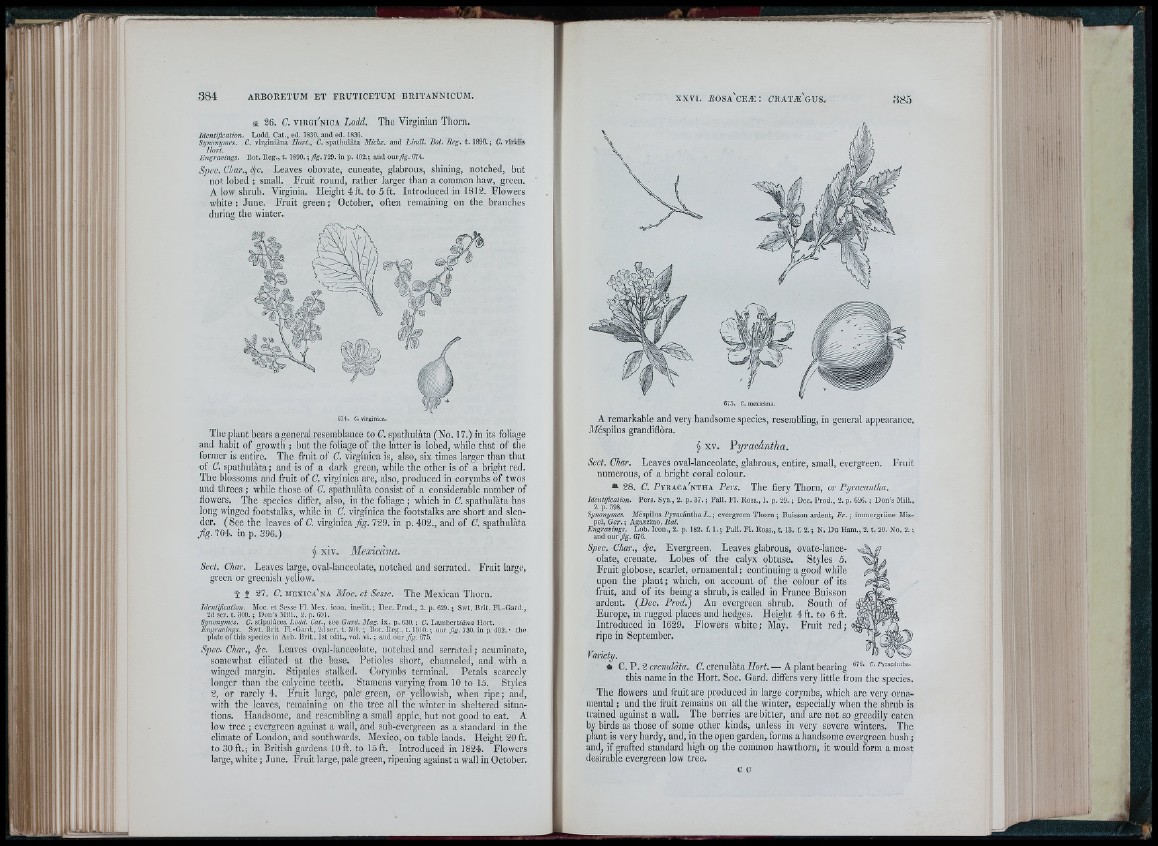
il'r
!ü 2 6 . C. v i k g i ' n i c a Lodd. The 'Virginian Thorn.
Idcntificalicm. Lodd. Cat., ed. 1830, and ed. 1830.
Synovymcs. C. virginiàna Hort., C. spathulàta Michx. and Lindl. Bot. Reg. t. 1890. j C. viridi»
Hort.
Engravings. Bot. Reg., t. 1890. ; fig. 729. in p. 402.; and oavfig. 674.
Spec. Char,, Ô'c. Leaves obovate, cuneate, glabrous, shining, notched, but
not lobed ; small. Fruit round, rather larger than a common haw, green.
A low shrub. Virginia. Height 4 ft. to 5 ft. Introduced in 1812. Flowers
white ; June. F ruit green ; October, often remaining on the branches
during the winter.
^ ^ I its foliage
and habit of growth ; but the foliage of the latter is lobed, whiÎe tha t of the
former is entire. The fruit of C. virginica is, also, six times larger than that
of C, spathulàta; and is of a dark green, while the other is of a bright red.
The blossoms and fruit of C. virginica are, also, produced in corymbs of twos
and threes ; while those of C. spathulàta consist o f a considerable number of
flowers. The species differ, also, in the foliage ; which in C. spathulàta has
long winged footstalks, while in C. virginica the footstalks are short and slender.
(See the leaves of C. virginica fig, 729. in p. 402., and of C. spathulàta
fig. 704. in p. 396.)
§ xiv. Mexicàna.
Sect. Char. Leaves large, oval-lanccolate, notched and serrated. Fruit large,
green or greenish yellow.
i 27. C. m ex ic a'n a Moc. et Sesse. The Mexican Thorn.
Identification. Moc. e t Sesse Fl. Mex. icon, inedit. ; Dec. P rod., 2. p. 629. ; Swt. Brit. Fl.-Gard.,
2d scr. t. 300. ; Don’s Mill., 2. p. 601.
Synonymes. C. stipulàce<a ¡.odd Cat., see Gard. Mag. ix. p. 630. ; C. Lamberttórira Hort.
Lngi-avings. Swt. Brit. Fi.-Gard., 2d ser. t. 300. ; Bot. Reg., t. 1910. ; our Jig. 730. in p. 402. • the
plate o fth is species in Arb. Brit., 1st edit., vol. vi. ; and our 675.
Spec. Char., Leaves oval-lanceolate, notched and serrated ; acuminate,
somewhat ciliated at the base. Petioles short, channeled, and with a
winged margin. Stipules stalked. Corymbs terminal. Petals scarcely
longer than the calycine teeth. Stamens varying from 10 to 15. Styles
2, or rarely 4. Fruit large, pale green, or yellowish, when ripe; and,
with the leaves, remaining on the tree all the winter in sheltered situations.
Handsome, and resembling a small apple, but not good to eat. A
low tree ; evergreen against a wall, and sub-evergreen as a standard in the
climate of London, and southwards. Mexico, on table lands. Height 20 ft.
to 30 ft.; in British gardens 10 ft. to 15 ft. Introduced in 1824. Flowers
large, white ; June. Fruit large, pale green, ripening against a wall in October.
■ i ! ’’
• t ' ,
i;; I
675. C. mexicàna.
A remarkable and very handsome species, resembling, in general appearance,
TlJespilus grandiflòra.
§ XV. Fyracàntha.
Sect. Char. Leaves oval-lanceolate, glabrous, entire, small, evergreen. Fruit
numerous, of a bright coral colour.
2 8 . C. P v r a c a ' n t h a Pers. The fiery Thorn, or Pyracantha.
Idciitification. Pers. Syn., 2. p. 37. ; Pall. F l. Ross., 1. p. 29. ; Dec. Prod., 2. p. 626. ; Do n ’s Mill.,
2, p. 598.
Synonymes. Méspilus Pyracúntha X. ; evergreen T h o rn ; Buisson ardent, F r .\ immergriine Mispel,
Ger. ; Agazzino, Ital.
Engravings. Lob. Icon., 2. p. 182. f. 1. ; Pall. F l. Ross., t. 13. f. 2. ; N. D u Ham., 2. t. 20. No. 2. ;
and our fig. 676.
Spec. Char., Evergreen. Leaves glabrous, ovate-lanceolate,
crenate. Lobes of the calyx obtuse. Styles 5 .
F ruit globose, scarlet, ornamental ; continuing a good while
upon the plant; which, on account of the colour of its
fruit, and of its being a shrub, is called in France Buisson
ardent. (JDec. Prodà) An evergreen shrub. South of
Europe, in rugged places and hedges. Height 4 ft. to 6 ft.
Introduced in 1629. Flowers white; May. Fruit re d ;
ripe in September.
Variety.
tt C .V . 2 crenulàta. C. crenulàta — A plant bearing c. pyracántha.
this name in the Hort. Soc, Gard. differs very little from the species.
The flowers and fruit are produced in large corymbs, which are very ornamental
; and the fruit remains on all the winter, especially when the shrub is
trained against a wall. The berries are bitter, and are not so greedily eaten
by birds as those o f some other kinds, unless in very severe winters. Tiie
plant is very hardy, and, in the open garden, forms a handsome evergreen bush ;
and, if grafted standard high on the common hawthorn, it would form a most
desirable evergreen low tree.
c c